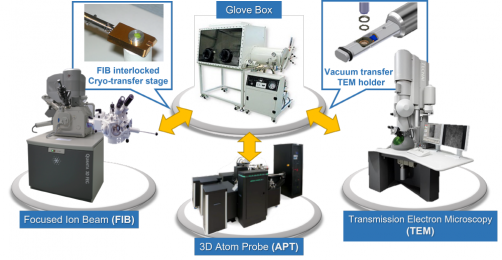Automakers worldwide are actively working on research and development to transform internal combustion engine vehicles into electric vehicles as part of global initiatives to achieve carbon neutrality. As a result, the race to enhance battery performance, which powers electric vehicles, is increasing.

Schematic diagram of KIST battery analysis platform. Image Credit: Korea Institute of Science and Technology (KIST)
Due to ongoing advancements in energy density and efficiency, lithium-ion batteries have maintained a commanding market dominance across most market categories since their introduction in 1991, from small home appliances to electric cars.
The expansion and deterioration of the anode material are two phenomena that occur within such batteries but are currently poorly understood.
According to a study from the Korea Institute of Science and Technology, a team under the direction of doctors Jae-Pyoung Ahn (Research Resources Division) and Hong-Kyu Kim (Advanced Analysis and Data Center) has been successful in observing how lithium ions’ movement causes anode material in batteries to expand and degrade in real-time.
It is commonly understood that numerous changes that take place in the interior electrode materials during the charging and discharging operations have an impact on the functionality and lifespan of lithium-ion batteries.
However, since important battery components such as electrodes and electrolytes are immediately polluted when exposed to the air, it is challenging to monitor such changes while the battery operates.
Therefore, the key to increasing performance and safety is accurate observation and study of structural changes in the electrode material during lithium-ion migration.
The lithium ions in a lithium-ion battery migrate from the cathode to the anode during charging and from the cathode to the anode during discharge. The KIST research team successfully saw a silicon-graphite composite anode in real-time as it was being investigated for usage in a high-capacity battery.
Theoretically, silicon has a charging capacity that is ten times more than graphite, the material used for traditional anodes. However, during the charging process, the volume of silicon nanopowders quadruples, making it challenging to guarantee performance and safety.
Nanopores made when the components of silicon-graphite composites were mixed might accommodate silicon’s volume growth during battery charging, altering the volume of the battery. However, no electrochemical voltage curves have ever directly observed nanopore functions.
The KIST research team determined the efficacy of the nanopores by directly observing the migration of lithium ions into the silicon-graphite composite anode during charging using a self-designed battery analysis tool. In the silicon-graphite composite, lithium ions move into the carbon, nanopores, and silicon.
The research team found that, contrary to earlier assumptions, silicon expands in volume through the micro-sized pores, whereas the nano-sized pores prefer to store lithium ions (fore-filling lithiation) before the lithium-silicon particles (Si lithiation).
The study team contends that developing high-capacity anode materials for lithium-ion batteries requires a revolutionary strategy that evenly distributes micro- and nano-sized pores to reduce silicon’s volume growth and enhance the material’s safety.
Just as the James Webb Space Telescope heralds a new era in space exploration, the KIST battery analysis platform opens new horizons in material research by enabling the observation of structural changes in electric batteries.
Dr Ahn, Head, Research Resources Division, Korea Institute of Science and Technology
Dr Head added, “We plan to continue the additional research necessary for driving innovations in battery material design, by observing structural changes in battery materials that are not affected by atmospheric exposure.”
The Ministry of Science and ICT financed the study as a component of the Korea National Research Council of Science and Technology’s (NST) Creative Convergence Research Project and the Korea National Research Foundation’s (NRF) Nano Material Source Technology Development Project.
The study’s results were published in the most recent issue of ACS Energy Letters, an international academic journal for batteries.
Journal Reference
Lee, H-J., et al. (2022) Lithiation Pathway Mechanism of Si-C Composite Anode Revealed by the Role of Nanopore using In Situ Lithiation. ACS Energy Letters. doi:10.1021/acsenergylett.2c01022.